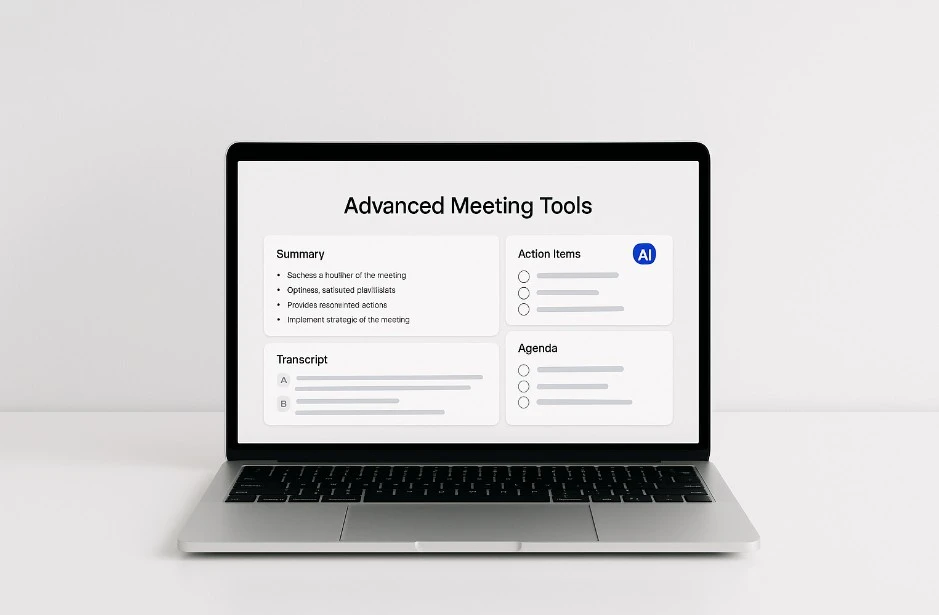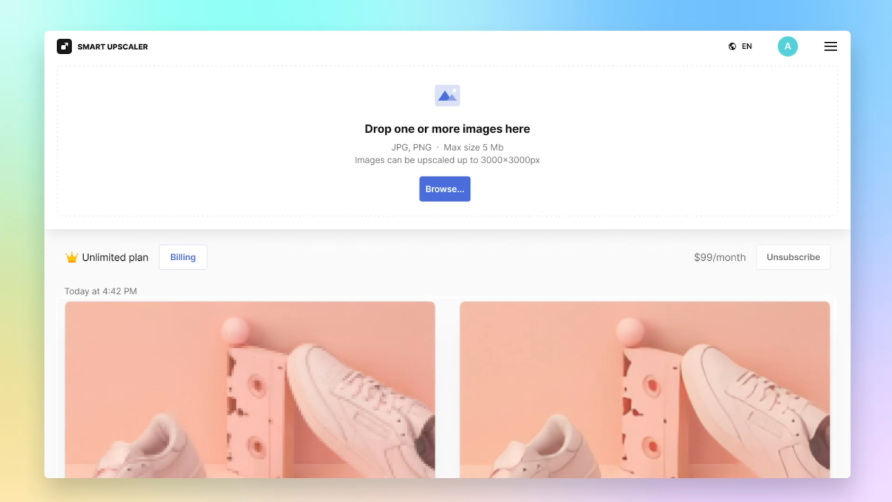IN THIS POST
The Evolution of Image Enhancement
Visual quality limitations present recurring obstacles for professionals across industries. When confronted with suboptimal source materials—whether historical images, user-submitted content, or resource-limited projects—practitioners need efficient solutions to elevate these assets to contemporary standards. The Smart Upscaler developed by Icons8 represents a specialized tool addressing these specific challenges through computational techniques that transform lower-quality visuals into enhanced versions while intelligently preserving critical elements.
Core Technical Framework
At its foundation, the Smart Upscaler employs neural networks specifically optimized for visual enhancement tasks. This approach fundamentally differs from conventional scaling methods that rely on pixel interpolation through mathematical algorithms. Instead, the system analyzes visual content through contextual understanding—recognizing structural elements such as contours, surface patterns, and physiognomic features—then reconstructs these components with enhanced definition rather than simply expanding existing pixel information.
This technical distinction holds significant implications for visual professionals. Where traditional enlargement inevitably sacrifices clarity when exceeding original resolution boundaries, the machine learning approach maintains definitional integrity while intelligently generating complementary details aligned with existing visual information.
Industry-Specific Applications
Design Profession Implementation
The graphic design community benefits substantially from the tool’s capacity to rehabilitate compromised visual elements. When confronted with inadequate client-provided resources—a recurring professional challenge—designers can transform marginally acceptable assets into properly usable components. This capability proves especially valuable during legacy brand refreshes where original high-resolution files may be unavailable, or when developing comprehensive visuals from preliminary conceptual renderings.
The system’s ability to maintain surface characteristics addresses specific technical challenges in specialized design fields, preserving fabric textures for apparel visualization and material properties for product representation—nuanced requirements that conventional enlargement tools typically fail to satisfy.
Development Environment Integration
Web and application developers regularly navigate resolution inconsistencies when implementing adaptive designs. The Smart Upscaler offers practical methodology for preparing visual assets that maintain integrity across device ecosystems. This functionality becomes particularly relevant when technical teams must incorporate existing assets or third-party resources not originally created for high-density display environments.
The platform’s batch processing capabilities align effectively with development methodologies, enabling systematic enhancement of multiple resources without individual manual intervention. This scalability directly addresses production requirements in software development contexts, where numerous visual elements may require consistent quality improvement.
Photographic Application Assessment
Professional photographers discover specific utility in the tool’s ability to extract additional detail from technically constrained captures. While not replacing proper exposure technique and composition principles, the system effectively rehabilitates images with moderate quality limitations or resolution restrictions.
Event photography specialists gain particular advantages when clients request enlargements beyond the technical specifications of original captures. The technology facilitates commercially viable large-format output from images that would otherwise demonstrate visible quality degradation. This capability effectively extends the commercial application range for existing image collections.
Marketing and Content Distribution Applications
Digital content specialists operating across multiple platforms must balance visual consistency with diverse format requirements. Media strategists frequently need to adapt existing visual assets for platforms with different dimensional specifications. The Smart Upscaler facilitates these transformations while minimizing the quality compromise typically associated with such adaptations.
Marketing departments working with historical campaign assets find significant value in modernizing visual elements without extensive recreation. The system effectively bridges technological gaps between archived materials and current display requirements, maintaining brand continuity while meeting contemporary technical standards.
Performance Evaluation by Content Category
Technical assessment reveals differentiated effectiveness depending on source material characteristics. The system demonstrates exceptional performance with photographic content containing organic elements, where its neural training shows clear advantages. Portrait imagery benefits from specialized facial enhancement algorithms that preserve natural skin textures while improving definition—a complex balance many alternative solutions struggle to achieve.
For design assets containing typographic elements, results demonstrate greater variability. While geometric shapes and solid color regions enlarge cleanly, text elements occasionally exhibit artifacts requiring additional refinement. This limitation reflects inherent challenges in preserving precise character forms, particularly at reduced sizes.
Technical and architectural imagery presents intermediate results, with structural components generally enhancing effectively while intricate details occasionally develop artifacts. Professionals working with these specialized content types should evaluate results individually rather than applying batch processing indiscriminately.
Those exploring related applications combining enhancement with creative transformation may consider specialized face swap ai online technologies that demonstrate how computational approaches extend beyond simple resolution improvement to more sophisticated visual manipulation. These parallel developments illustrate the expanding capability spectrum in algorithmic image processing.
Professional Workflow Consideration
The web-based interface provides straightforward accessibility but introduces certain operational considerations. Professional environments with established creative systems may find the standalone nature requires additional integration compared to embedded solutions within existing software ecosystems. However, this independence also creates accessibility for team members without specialized application access.
The quality improvements justify these minor workflow adaptations for most implementations. Organizations managing extensive visual resources benefit from systematic enhancement of archived materials, effectively extending the practical lifespan of existing assets without comprehensive redevelopment.
Technical Constraints and Considerations
Certain limitations warrant acknowledgment for thorough professional evaluation. The processing introduces subtle modifications to specific image properties, potentially altering precise color values or textural characteristics of original materials. While these transformations generally enhance perceived quality, color-critical applications may require supplementary calibration procedures.
Processing duration correlates with visual complexity and target resolution, potentially creating production constraints for high-volume operations. Organizations should develop appropriate workflows accommodating these processing requirements, particularly within time-sensitive production schedules.
Storage implications merit consideration, as enhanced files typically require substantially greater capacity than source materials. This factor influences both active project management and long-term archival planning.
Economic Efficiency Analysis
Cost assessment reveals distinct advantages compared with traditional methodologies. Manual enhancement by qualified designers typically requires substantial time investment, with corresponding labor expenses that rapidly exceed subscription costs for automated solutions. Even modest efficiency improvements justify the investment for professionals regularly handling visual assets.
The subscription access model aligns effectively with project-based work patterns, permitting targeted utilization during intensive production periods. Compared with perpetual license software requiring substantial initial investment, this approach offers accessibility for independent practitioners and small teams with variable workloads.
Educational institutions discover particular value in the system’s accessibility, providing students practical experience with contemporary enhancement techniques without prohibitive licensing expenses. This availability helps prepare emerging professionals for industry practices while accommodating academic budget constraints.
Competitive Positioning Assessment
Among available enhancement technologies, the Smart Upscaler effectively balances processing sophistication with operational accessibility. More complex alternatives offer incremental quality improvements in specific applications but typically demand greater technical expertise and computational resources. This positions the tool appropriately for creative professionals rather than specialized technical operators.
Compared with standard enlargement functions in conventional graphics applications, the quality differential becomes immediately apparent, particularly at higher scaling factors. The neural network approach consistently maintains edge definition and textural integrity that conventional algorithms invariably compromise.
Open-source alternatives demonstrate promising capabilities but generally lack the streamlined interface and consistent performance necessary for production environments. Organizations requiring occasional implementation might explore these options, while professionals requiring reliable results typically favor the consistent performance of developed commercial solutions.
Professional Implementation Recommendations
The Smart Upscaler represents a valuable addition to the professional visual toolkit, addressing specific quality challenges with targeted technology. Its effectiveness varies by content type and implementation requirements, necessitating critical evaluation for each application scenario.
For visual communication specialists working with resolution-constrained materials, the system offers practical solutions to common production challenges. While not eliminating fundamental requirements for quality source materials in optimal circumstances, it provides realistic resolution for the compromise situations professionals regularly encounter.
Organizations should consider strategic integration within established visual asset management workflows, applying the technology selectively where source limitations would otherwise compromise output quality. This implementation approach maximizes technological benefits while acknowledging specific operational context within broader production methodologies.
Recommended Articles

9 API Security Best Practices Every Booking Platform Needs
BOOKAFY BLOG 9 API Security Best Practices Every Booking Platform Needs IN THIS POST Your organization is like a finely tuned machine where systems work together in harmony to keep

Why Remote Teams Secretly Appreciate Timesheet Software Like Workstatus
BOOKAFY BLOG Why Remote Teams Secretly Appreciate Timesheet Software Like Workstatus IN THIS POST Remote work has transformed how businesses are operated. Different cities; or even nations, are collaborating on

All About Optimizing Your Booking Page for Search Engines
BOOKAFY BLOG All About Optimizing Your Booking Page for Search Engines IN THIS POST Have a booking page, but not getting as many customers as you expected? That could be

From Side Hustle to Full-Time: How ESL Tutors Scale Their Income with Smart Tools?
BOOKAFY BLOG From Side Hustle to Full-Time: How ESL Tutors Scale Their Income with Smart Tools? IN THIS POST Do you remember working at your typical 9-5 job? You might

The Appointment Revolution: How to Schedule Like a Pro with These Simple Hacks
BOOKAFY BLOG How to Schedule Like a Pro with These Simple Hacks IN THIS POST Time significantly impacts how people evaluate their experiences. When time is wasted, customers often remember

Improving Team Efficiency with Advanced Meeting Tools
BOOKAFY BLOG Improving Team Efficiency with Advanced Meeting Tools IN THIS POST Effective meeting coordination is essential for maintaining productivity within teams. By utilizing advanced tools, teams can streamline scheduling

